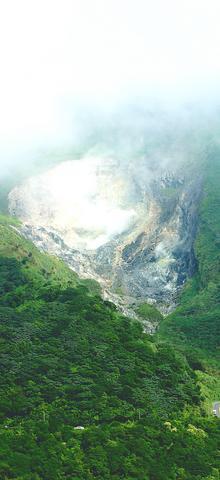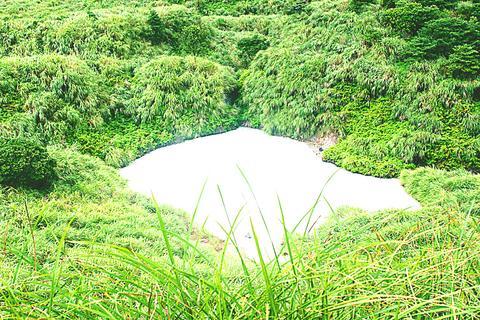Yangmingshan National Park is a welcome retreat from the city of Taipei spread below . It offers a convenient location for fresh air, walks, lunch and general recreation.
Start at the Park Headquarters and Visitor Center, in the center of the park. The bilingual staff are available to answer your queries from 9am until 5pm, Monday to Sunday. They also provide a map of Yangmingshan, which is equally helpful.
Something to prepare yourself for is the fact that the rolling hills and twisting paths throughout the park are not quiet. On the weekends there are families, but in the week there is the overwhelming noise of cicadas and their screeching symphonies.

PHOTO: ADAM ULFERS, TAIPEI TIMES
The Lengshuikeng area in Yangminshan is one of the most easily accessible areas and well-known attractions. These include a spring with warm rather than piping hot water; and Milk Pond, where a path leads visitors, old and young, on a mild stroll bordering the waters.
At nearby Qingtiangang is a picnic spot, popularly known as Buffalo Meadows because of the number of water buffalo that squat there daily. This is a great spot to bring a spread of food and drink with your significant other or family.
From both Lengshuikeng and Qingtiangang, Seven Star Mountain is impossible to miss. It towers over Taipei and the rest of the park as the tallest peak.

PHOTO: ADAM ULFERS, TAIPEI TIMES
The stairway trail leading to the summit, at first sight appears a manageably short 2.5km. At points though, the path becomes a nerve-racking, almost vertical ascent. The trail begins at Seven Star Park and after a brief stair climb one finds a paved one-way road. Once the trail passes a radio broadcast building, it becomes more demanding and the views more breathtaking. The hike requires no special skill beyond the ability to climb what seems innumerable stairs.
Seven Star Mountain is an old volcano and is still spitting on its western slope at Xiaoyoukeng. The vents are the most active in the area, so unless you're keen on dying from sulfur asphyxiation or serious burns, keep your distance. The best view of the spouts is from across the valley on Bailaka Road. Drive along the road adjacent to the sulfur pits and then turn left on Bailaka Road toward Bamboo Lake valley on your way to Datun Nature Park.
Datun Mountain is on the western side of the park surrounded by soft, handicapped-accessible trails. The flat hike initially leads to pleasantly landscaped Erzhiping Pond.

PHOTO: ADAM ULFERS, TAIPEI TIMES
Datun Mountain is actually three mountains sharing the same name, composed of a main, southern and western peak.
There are trails to visit each peak and a circumnavigation of the summits and sites in the area is well worth the time. The main peak, the highest, has a heavily trafficked road which goes all the way to the top.
The other two peaks are an entirely different story. The paths are well marked on the complimentary map from the visitor center, but the overgrown Japanese silver grass shrubs are not going to let you find them as easily. If you have your heart set on the southern and western summits, leave Grandma behind unless she insists on some thrills and spills.
The trails have sections with trees you would swear have eyes and others that are steep, slippery and lined with ropes to assist along the way. The most exciting sections provide a cliffhanger-like elation, but are disappointingly short.
If you are looking for technical rock climbing or weekend camping trips, a long trip down south is probably your best bet. Otherwise Yangmingshan is an excellent alternative for Taipei City residents, providing the same distraction for a smaller investment of time and energy.
Follow the trails laid out here or choose your own adventure, just get out and make a day of it.

On April 26, The Lancet published a letter from two doctors at Taichung-based China Medical University Hospital (CMUH) warning that “Taiwan’s Health Care System is on the Brink of Collapse.” The authors said that “Years of policy inaction and mismanagement of resources have led to the National Health Insurance system operating under unsustainable conditions.” The pushback was immediate. Errors in the paper were quickly identified and publicized, to discredit the authors (the hospital apologized). CNA reported that CMUH said the letter described Taiwan in 2021 as having 62 nurses per 10,000 people, when the correct number was 78 nurses per 10,000

As we live longer, our risk of cognitive impairment is increasing. How can we delay the onset of symptoms? Do we have to give up every indulgence or can small changes make a difference? We asked neurologists for tips on how to keep our brains healthy for life. TAKE CARE OF YOUR HEALTH “All of the sensible things that apply to bodily health apply to brain health,” says Suzanne O’Sullivan, a consultant in neurology at the National Hospital for Neurology and Neurosurgery in London, and the author of The Age of Diagnosis. “When you’re 20, you can get away with absolute

May 5 to May 11 What started out as friction between Taiwanese students at Taichung First High School and a Japanese head cook escalated dramatically over the first two weeks of May 1927. It began on April 30 when the cook’s wife knew that lotus starch used in that night’s dinner had rat feces in it, but failed to inform staff until the meal was already prepared. The students believed that her silence was intentional, and filed a complaint. The school’s Japanese administrators sided with the cook’s family, dismissing the students as troublemakers and clamping down on their freedoms — with

As Donald Trump’s executive order in March led to the shuttering of Voice of America (VOA) — the global broadcaster whose roots date back to the fight against Nazi propaganda — he quickly attracted support from figures not used to aligning themselves with any US administration. Trump had ordered the US Agency for Global Media, the federal agency that funds VOA and other groups promoting independent journalism overseas, to be “eliminated to the maximum extent consistent with applicable law.” The decision suddenly halted programming in 49 languages to more than 425 million people. In Moscow, Margarita Simonyan, the hardline editor-in-chief of the